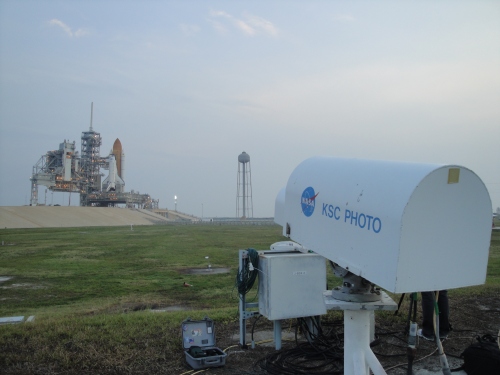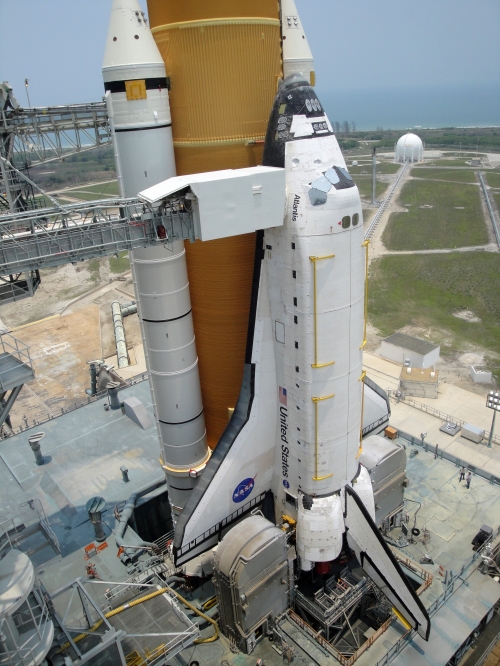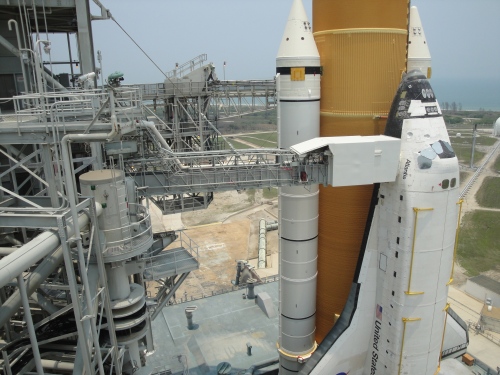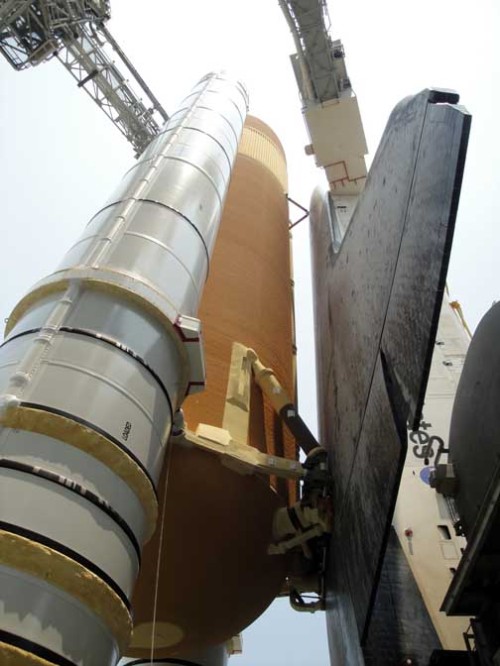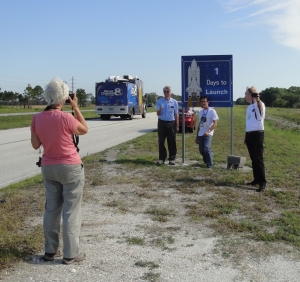
As soon as we pulled off for the obligatory morning picture of the Days-to-Launch sign, cars pulled off and piled up around us. Happy surprise -- we've been hanging and talking with these guys. This is a busy picture. I'm taking a picture of them, including Carol Anne who is taking a picture of them, and the guy on the far right is taking a picture of me. Covering stories like shuttle launches, reporters are easily amused and often have too much time on their hands for stuff like this.
This morning we will move to the Cape and remain at the Pad 39 Media Site at Kennedy Space Center until either STS-134 is launched, or until the mission is scrubbed.
8:30 am, Celebration, FL. With Carol Anne in tow, we make the morning provisioning stop at a donut shop across on Highway 192, then head onto the 417 for the Beachline (State 528) and the coast. As expected traffic at this hour on a Sunday morning is nill.
We are on our way to watch the rotating service structure (RSS) be retracted from the shuttle at Pad 39-A. It is scheduled for Noon, and we have to be on the bus and clear of security by 10:30 am. No problem. We breeze over to the coast and through the gates onto Kennedy Space Center and arrive early. The day is surprisingly comfortable with a breeze and although the sun is out, humidity is low.
I’ve covered this event before, but Carol Anne has not. I notice that the media has been moved back from the gate leading up to the launch pad another few yards. It doesn’t matter. If someone is in front of you, as the tripod guys always are, just step back a few feet and you can see the entire pad. It’s not hard to miss.

Roughly a quarter to a third of the 1,500 accredited reporters showed up for the trip out to Pad 39-A Sunday morning, May 15, 2011, to watch the rotating service structure (RSS) be retracted from the shuttle. As a result, NASA needed a tons of buses. The rotating service structure (RSS) retraction is shown in a sequence of five pictures -- scroll down. It's the next post following this.
. Happily, and surprisingly, the rotating service structure (RSS) begins about 10-minutes ahead of schedule and well before 1 pm we are back at the Media Center.
To see the Retraction of the rotating service structure (RSS) : scroll down — the retraction is shown in a series of five pictures in the post directly following this post.
1 pm, media center. This place is still empty, and as we left the bus we noticed the parking lot was emptying out. We have a short debate as to whether we should leave KSC and find lunch. It is a short debate. We have so much time that it cannot matter even if we begin to get caught in the growing crowds that will likely be flocking to the Cape later this afternoon and evening.
I field a phone call from my cousin. A friend of his, a motion picture director, wants my advice as to where he (the director and his family) should view the launch.

The shuttles are brought to the launch pads on Crawlers. The roadbed of the Crawlway is river rock from Alabama and Tennessee. Pete Crow is among the reporters and photographers lying on the Shuttle Crawler near Pad 39 A on Sunday, May 15, 2011, waiting for the RSS to be retracted from Shuttle Eneavour. This is the second to last shuttle mission, STS-134.
Well, ahem, he probably should have bluffed his way into the VIP section starting weeks ago, but it’s too late now. I am running a link to the public viewing areas that NASA recommends on each of these blog posts because it is often difficult to find the link on the NASA site. I refer them to NASA and that link and am hoping for the best for them. Fact is, in all the launches I’ve seen, I’ve only watched one outside of the press site so I’m a complete pilgrim on where to watch launches around here.
1:30 pm Shuttles Restaurant. Shuttles is an amiable sports bar south of Kennedy Space Center Gate 2 on State Highway 3. We first found it a few launches ago. It is much closer than retreating all the way to Titusville to the west or going all the way south to Cocoa Beach. The real draw of this place, however, is the great food.

Shuttles, a sports bar, on State Road 3 south of the entrance to KSC. Good food, but could it be an endangered species? -- with the shuttle program ending, this could put a great restaurant/sports bar under duress unless you drive over and have a bite and a beer every so often. And no, my brother-in-law doesn't own the place.
Shuttles, winkwink, is obviously named for the Space Shuttles, but someone around there also seems to be a Boston Red Sox fan.
The place is empty. Good for us, but not so good for Shuttles. We are completely mis-gauging the size of the crowds. So far the roads are completely empty. In the end we zip over to Shuttles and back seeing virtually no cars.
3:00 pm Media Center. We ease into the empty media parking lot. We now suspect that the media will filter in beginning early evening. If we’re right, and if the media is coming at all, this is a new age. It used to be that the media would be here .
4:00 pm. Carol Anne is out sleeping in the car and I’m in the completely empty media annex where my work space is. I have checked the adjoining workspaces and now find most are unassigned. On April 29, they were all assigned. Apparently lots of media organizations are not returning.

Astronaut Michael Good being interviewed. There's plenty to hate about Astronauts -- they're good-looking, articulate, intelligent and they're the kind of guys who always get the girl. The problem is, however, they're also likable, intelligent and engaging to be around. I encountered Mr. Good briefly as he passed through the annex on his way to interviews on Sunday, May 15, 2011.
. A guy in a blue jump suit has wandered into the annex and is drfiting around looking lost. He hwinds up at the back tables behind me reading names of organizations taped to the tables.
He is astronaut Michael T. Good who he flew on two shuttle missions and now lives in Colorado. Check his entire NASA bio out HERE .It’s worth reading. I’ve interviewed Astronauts over the years. It is hard not to be holy-freaking-cow about Astronauts — about where they have been, about how superbly trained they are, about how just plain gutsy it is to climb the shuttle and be launched at many times the force of gravity into space, and lots more.
I’m standing here face-to-face with a guy who has logged seven minutes shy of 30 hours of walking in space, and flown two shuttle missions (May 2009, STS-125, and May 2010, STS-132).
With Astronauts, and with anyone you’re interviewing, the thrust of any story is always “tell me about it”. But with Astronauts? — how can they ever really tell you about it?
I go back and introduce myself to Astronaut Good. I ask him if interviews with Astronauts that NASA is offering are one-on-one or in crowds. He says he has no idea, and in fact says he is lost, adding he is rarely if ever has been to the media site. We walk over to the main media site and we chat along the way. In the main media center he is quickly oriented, finds his NASA handler and heads for his scheduled interviews.
10 pm, media site. Gorgeous night at the Cape. Gentle wind, nearly full moon, humidity is low. Carol Anne and I walk the site, still looking for the Tweeters. Of the 150, only 80 will return. NASA polled them to see who wanted to come back a second time. Only half were able to do so. Tweeters pay their own way; last time the April 29 launch was on a Friday.
Back at the media center, I move my stuff from the annex to an open table in the back of the main media center. Only three NASA personnel are working the site, including an affable PR woman from Marshall Space Flight in Huntsville, AL. We chat. It has been years since I have been in Huntsville, but in the 1950s my brother-in-law worked as a very junior memberon Wernher von Braun‘s engineering team there at Redstone Arsenal, and another brother-in-law’s family owned the Coca-Cola bottling company there and a lot of the downtown. My eldest niece was even born there.
A long time ago. The town has grown.
Media too seem to be missing in action. From my past experiences of being buried in traffic, I may have over-reacted to the number of people who would be flowing out to the Cape to watch the launch.
I’m weary and head for the car to sleep. Before I go I see that the media is being invited to watch the launch from Banana Creek, the VIP site. I sign up, but before I go I’ll check and try to learn more about it.
A decision on whether to fuel will be made at 11 pm. and if the go is given, the tanks will be filled shortly before 3 am. I’ll be asleep long before either event. … and to to bed.
“petecrow/NASA” © 2011 by / Peter M. Crow and the Peter Michael Crow Trust and by Seine/Harbour® Productions, LLC, Studio City, California.
Read Full Post »
 The Mars Science Lab, atop an Atlas rocket, is moved from its hangar (left) to Pad 41 (right — the four lightning towers) where it is scheduled to begin a 9 month trip to the surface of Mars at 10:02 am, Saturday, November 26, 2011. This photo, taken about 9 am, Friday, November 25, 2011, shows the MSL stack about midway between the pad and the hangar. The photo was taken from The Beach House, a relaxation villa for astronauts (and once a private from before the space center took the property) on the Atlantic Ocean beach. On the extreme far right of this photograph, Pad 39-A, is visible. The final shuttle missions were launched from 39-A.
The Mars Science Lab, atop an Atlas rocket, is moved from its hangar (left) to Pad 41 (right — the four lightning towers) where it is scheduled to begin a 9 month trip to the surface of Mars at 10:02 am, Saturday, November 26, 2011. This photo, taken about 9 am, Friday, November 25, 2011, shows the MSL stack about midway between the pad and the hangar. The photo was taken from The Beach House, a relaxation villa for astronauts (and once a private from before the space center took the property) on the Atlantic Ocean beach. On the extreme far right of this photograph, Pad 39-A, is visible. The final shuttle missions were launched from 39-A. .
.





